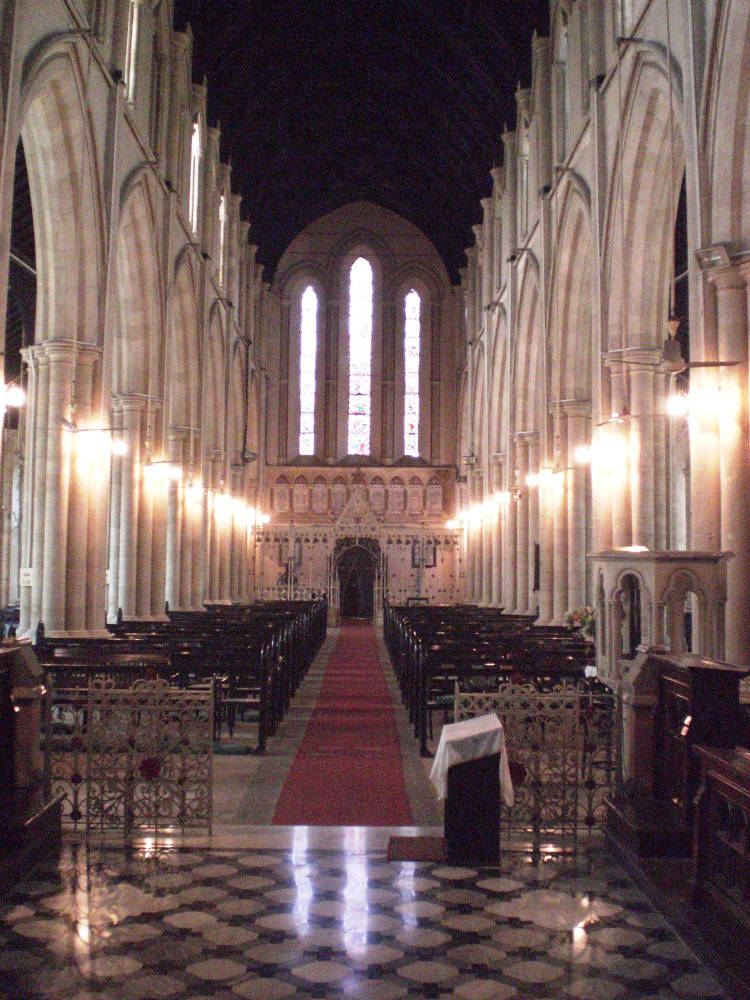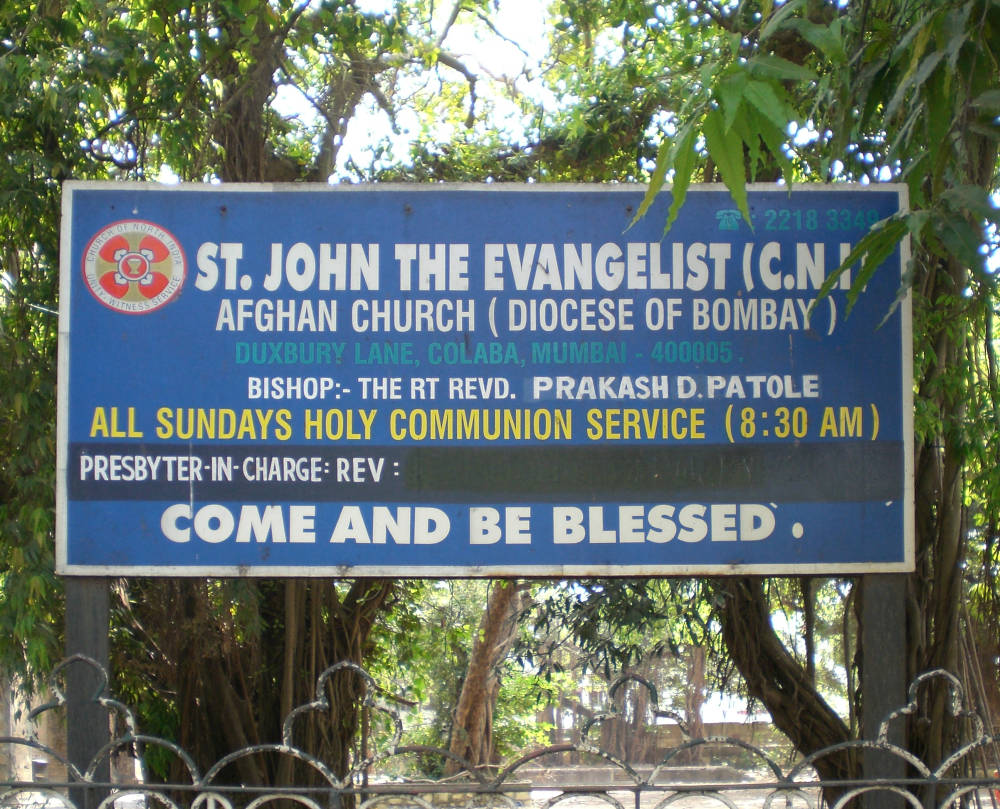Photographs and image scans by the author. [You may use any of these images, apart from the last one, without prior permission for any scholarly or educational purpose as long as you (1) credit the source and (2) link your document to this URL or credit the Victorian Web in a print one. Click on the images to enlarge them.]


Left: St. John the Evangelist, the Afghan Church, Mumbai. Henry Conybear, Architect. Begun 1847; consecrated 1858. Right: Interior with the reredos, tiles, pews and screen and the Afghan War memorials by William Butterfield. [Click on images to enlarge them.]
The disaster of 1842 in Afghanistan shook Britain to the very core. Almost a whole army had been destroyed on its march back to British India from Kabul in the narrow passes of Khord Kabul and Jugdulluk. Thousands of men lay dead, their bleached bones later discovered by colleagues in General Pollock’s Army of Retribution.
But the British have never been slow to exploit a good disaster. Lady Elizabeth Butler’s mawkish depiction Remnants of an Army (1879; Tate Britain N01553) of Assistant Surgeon William Brydon arriving at Jalalabad as the sole survivor, captured the national mood. And Lady Sale’s epic story of her period of captivity became a best-seller. Much later William Barnes Mollen’s Last stand at Gandamak shows the heroic 44th Regiment and Lieutenant Souter with the regimental colour tied around his waist. Few would have remembered that Lady Sale had described the 44th’s disgraceful and cowardly conduct during the earlier retreat.
Hidden in Colaba, the leafy military cantonment area of south Mumbai (formerly Bombay), is the “Afghan Church” constructed to commemorate the tragedy. It had, after all, been the Bombay and Bengal Presidency armies of the East India Company which had suffered most from the disaster.

The nine-bay memorial with memorials for officers from two dozen units. [You can enlarge the image enough to read the names by clicking twice upon it.]
The first designs were submitted by John Macduff Derick but in 1845 they were rather tersely rejected; “The Committee regret to state that Mr Derick’s beautiful design for Colaba, after all the pains taken to adapt it to the requirements of the climate, has been found altogether unfit for the purpose, as well as requiring an expense for its erecting far surpassing the extent of any funds which can be provided for that end.” Instead the Committee turned to the city engineer Henry Conybeare to undertake the task in 1847, and in 1858 the Afghan Church was consecrated. In the amateur tradition of the day Conybeare was really a civil engineer who had gone out to India to work on the Great Eastern railway and later devoted himself to the water supply for Bombay; but he took a gothic church in his stride. William Butterfield (well known for his gothic-revival buildings in Oxford colleges) was responsible for the reredos, tiles, pews and screen and the Afghan War memorials themselves, tastefully decorated in different coloured local marble, basalt and limestone. The stained glass is by William Wailes, perhaps most famous for the west window of Gloucester Cathedral.


Left: Sign for the Afghan Church. Right: Memorial plaque inside the church.
Nowadays the church is eerily quiet with just the rustling of bats in the roof timbers. The pews still have the slots to enable soldiers to have their rifles to hand in case of emergency. These “rifle pews” were brought in after the 1857 Mutiny which began in Meerut when the garrison was attending evening service unarmed.


Left: The Rifle pews. Right: Memorial plaques inside the church.
When the Second Afghan war ended in 1880 it was natural enough for additional monuments to be added to the church. A long memorial of nine bays was constructed directly beneath Wailes’s west window intricately inlaid with local coloured stone; probably the finest military monument of the period. Another item which particularly caught my attention was the wording on the step of the high altar describing some men as “Brethren of the Guild of the Holy Standard Southern Afghanistan”. This sounded rather mysterious and this sense was reinforced when I discovered that there is a similar inscription in the chapel on the battlefield of Isandlwana in South Africa, the site of another British disaster in 1879.

Inscription on the marble step near the high altar.
The Reverend A H Etty, an army chaplain in India, wrote in 1894 “I wish to take this opportunity of bearing witness from the distant parts of India to the great good that that guild has done amongst the soldiers in India. I am one of the original members, and have worked [with] that guild; and wherever I have been there is a sister guild for soldiers' wives and daughters the Guild of St. Helena. These are of the greatest help to chaplains in India in bringing soldiers and their families together and making them true communicants.”
According to John Pollock’s biography of Lord Kitchener (himself a member) “Guild brothers of the Holy Standard pledged themselves to support one another and to set a Christian example “to be sober, upright and chaste; to be regular in their private prayers; to receive the Holy Communion at least three times a year; to avoid immoral books, to pray for other people, help the chaplains and promote the religious and social welfare of soldiers and their families.”. Clearly this was a long way from Kipling’s “brutal and licentious soldiery”.
But Parliament was distinctly uncomfortable about this shadowy Guild. A question in 1903 sought; “To ask the Secretary of State for War if he will state what is the position which the Army Guild of the Holy Standard occupies in relation to the Army and the War Office; whether it participates in any way in votes of public money or has the use of Government buildings; and whether the holding of any official position in this guild by the Chaplain General to the Forces has been recently the subject of Army Regulation.”
A newspaper report from 20th April 1903 reveals what the Member of Parliament feared; that the Guild was providing cover for Catholic or Anglo-Catholic rites.
Many aristocratic ladies including the President and Vice Presidents of the Ladies’ League for the Defence and Promotion of the Reformed Faith of the Church of England have strongly protested against the proposal of the Army Guild of the Holy Standard to hold a memorial communion at St Pauls [Cathedral] in commemoration of soldiers who fell in war [the recently ended Boer War]. The Ladies declare that the communion is an attempt to introduce into the cathedral a requiem mass for the dead after an absence of 350 years. The Chief Chaplain of the Forces (Bishop Taylor Smith) has resigned from the membership of the Guild and refused to sanction the service. The Archdeacon of London Venerable W M Sinclair is strongly opposed to the service which he says is obviously largely Roman Catholic.”
In 1907 the Guild merged with the Guild of St Helena to form the Army Guild, which gradually faded from view. But the Afghan Church in Mumbai remains, slightly forlorn, a forgotten monument to Britain’s involvement with Afghanistan.
Further reading.
Dunkley, The Rev C. Official Report of the Church Congress 1894. London: Bemrose, 1894.
Hansard. Questions in the House. London. 27th April 1903.
Macrory, Patrick. Signal catastrophe. London. Hodder and Stoughton, 1966.
Mottram, Phil. John Macduff Derick. A biographical sketch. Ecclesiology Today. January 2004.
Pollock, John. Kitchener. London; Constable, 2001.
Sale, Lady. A Journal of the disasters in Afghanistan. London; John Murray, 1843.
Sydney Morning Herald. 23rd April 1903. Page 4.
Last modified 4 May 2015